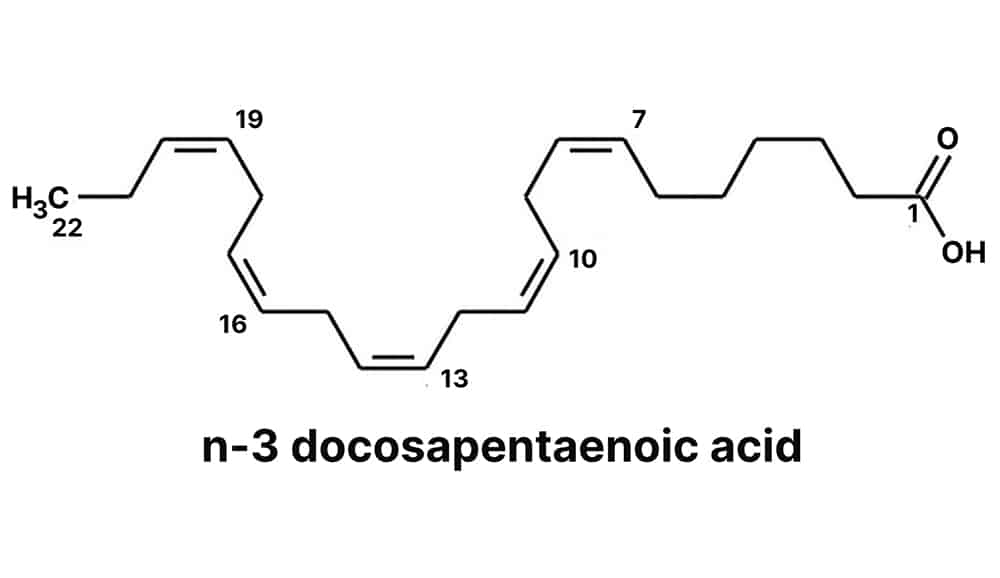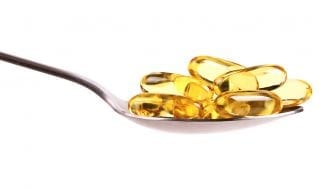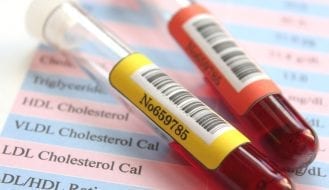What Is DPA in Fish Oil? What You Should Know
In the omega-3 fatty acid world, there are plenty of types and acronyms that come to the family party. We’ve got EPA and DHA, the two omegas that usually take center stage in dietary supplements. But there’s also DPA, the often-overlooked sibling in the omega-3 family.
Like a team of superheroes, each of these essential fatty acids brings unique strengths to the table. And as more research is starting to uncover, DPA packs a punch, with noted benefits for heart health, brain health and more.
So what exactly is DPA in fish oil, and why do we need it in our diet? Let’s take a closer look.
What Is DPA?
DPA (short for docosapentaenoic acid) is a lesser known, but still important omega-3 fatty acid. To better understand what DPA is, you first need some context. Let’s start by going back in time about 50 years.
In the late 1960s, doctors believed that consuming fat – any kind of fat! – caused heart disease. But two researchers from Denmark observed that this idea didn’t hold up in all cases. The Inuits in Greenland reported few heart disease cases despite consuming large amounts of fat from fish and seal blubber.
The researchers analyzed the fatty fish and seal blubber. They discovered that they contained especially large amounts of two omega-3 fatty acids called EPA (eicosapentaenoic Acid) and DHA (docosahexaenoic Acid). For this reason, EPA and DHA were crowned as responsible for the heart health benefits, while other fatty acids in fish and seal got less attention.
DPA is one of those previously overlooked fatty acids. As omega-3 research evolves, we’re learning more about the unique roles DPA plays in the cell alongside EPA and DHA. Ensuring a balanced intake of all these fatty acids is essential for health and wellbeing.

A Short Chemistry Lesson
Similar to EPA and DHA, DPA is a long-chain omega-3 fatty acid that our body cannot produce on its own.
DPA has a similar chemical structure to EPA, with one additional double bond and 2 extra carbon chain units.
Why is this important? It matters for two reasons:
1) All of these double bonds mean you’ve got a flexible and highly excitable molecule on your hands. That’s good since our cells need flexible, fast moving molecules to carry out many of their functions.
2) Because of its chemical structure, DPA is able to transform into EPA or DHA depending on the body’s needs. More on that below!

Double Bonds: The Reason Omega-3s Work
What makes long-chain fatty acids like EPA, DHA, and DPA essential for the human body is their unique structure, characterized by multiple double bonds. These double bonds act like hinges, allowing the molecules to be flexible and adaptable, which is crucial for forming cell structures.
Think of these fatty acids as different types of ropes, each serving a specific purpose. Some ropes are longer and more flexible, while others are shorter and stiffer. Our diets often lack enough of the long, soft ropes (like DPA, EPA and DHA), leading our bodies to rely on the shorter, stiffer ones that aren’t suitable for many vital functions. No wonder omega-3 deficiency is linked to a host of health problems, from skin issues to cognitive decline and early death.
DPA vs. EPA and DHA
EPA, DHA and DPA have many overlapping functions when it comes to human health. These omega-3s unite to fight inflammation, regulate gene expression, and support cell membrane function, to name a few benefits.
But these fatty acids also play unique roles in the cell. In simple terms, DHA is considered to be most important for brain and eye health, while EPA is thought to have more anti-inflammatory power.
DPA serves as an intermediary between EPA and DHA and can shape shift between them. Think of DPA as a traffic director at an intersection. When cells require more long-chain DHA, DPA can adapt itself into DHA as a flexible substitute. Conversely, if your cells need more EPA, DPA can reshape itself accordingly.
But DPA has more functions than just transforming into other fatty acids. DPA can also be utilized in its original form. Intriguingly, DPA comes in higher concentrations in human breast milk and adult blood than EPA. It’s also incorporated into human plasma and red blood cell lipids at a faster rate than EPA, pointing to important physiological roles.
Let’s take a closer look at DPA’s beneficial effects below.
The Health Benefits of DPA

To make matters more complicated, scientists struggled to assess if the results were due to DPA itself or its conversion into either DHA or EPA.
Steadily though, scientists are learning more about DPA’s unique effects on the human body. Here are some of things DPA appears to do especially well in our bodies:
• Reduce blood clot risk. In animal and human cell studies, DPA intake appears to prevent the clumping of platelets more effectively than DHA or EPA intake.
• Improve lipid metabolism. DPA seems to enhance how the body processes fats, potentially leading to better cholesterol levels.
• Promotes endothelial cell migration. DPA aids in the movement of cells that line blood vessels, which is essential for good vascular health.
• Resolves chronic inflammation. Reducing chronic inflammation is one of the most important ways to protect the body from health issues like heart disease, many kinds of cancer, autoimmune problems, and much more. Thankfully, omega-3s are very good at reducing inflammation. Like EPA and DHA, DPA serves as the precursor for specialized pro-resolving mediators called SPMs. These SPMs help moderate pain and inflammation in the body. Importantly, EPA, DHA and DPA act as substrates for different types of beneficial SPMs. So think of Pokemon. You want to collect them all.
• Acts as a storage depot for EPA and DHA. A human supplementation trial using 99.8% DPA suggested that DPA likely serves as a reservoir for other beneficial fatty acids, like EPA and DHA, in the body.
So how do these benefits play out in practice? Again, there aren’t that many human trials done yet. But there are good insights from cell and animal studies. Let’s delve deeper.
Anti-Cancer Effects
Several studies suggest that DPA may have anti-cancer effects. In mice studies, this omega-3 fatty acid slowed tumor growth and the pathological spread of breast, colon and prostate cancers. It also improved the survival rate of the mice, helping boost their appetite, weight and muscle mass.
Recent research on colorectal cancer also found that DPA had anti-proliferative and pro-apoptotic effects. In other words, it slowed down tumor cell growth and promoted tumor cell death. Of the three types of omega-3s studied, DPA showed the strongest results in both laboratory and animal models.
Cardiovascular Effects
Studies suggest that DPA may offer health benefits previously linked only to EPA and DHA.
For example, new research indicates that DPA can help improve cholesterol and triglyceride levels, similarly to EPA and DHA. One study found that DPA lowered non-HDL cholesterol levels by 50% in hamsters.
DPA has also been shown to reduce the expression of inflammatory genes. That’s important since inflammation in the walls of the blood vessels contributes to atherosclerotic plaques, leading to cardiovascular disease.
Although research is still limited, low DPA levels have also been linked to several cardiovascular issues, including:
- Higher risk of heart attacks.
- Higher total mortality rates, especially from strokes.
- High triglyceride levels.
On the flip side, high DPA levels are associated with lower levels of C-reactive protein, an inflammatory marker. The same link cannot be consistently said for EPA and DHA, pointing to a potential unique benefit of DPA.
For these reasons, many scientists are excited about the potential benefits of DPA for heart health.
Brain Effects

In one Alzheimer’s disease study, researchers added DPA to the diets of rats. They discovered that the DPA helped protect the brain cells in an area called the hippocampus – the most important brain center for learning and memory.
The researchers theorized that DPA might be important for protecting the brain from age-related memory decline by improving learning and memory abilities. After all, DPA reduces harmful inflammation and stress in the brain, which are two major factors in memory loss.
Sources of DPA
Eating more fatty fish, like salmon and mackerel, is one of the best ways to increase your intake of DPA. For example, raw salmon can provide as much as 393 mg per 100 gram portion of fish (hello, sushi)!
There’s also a decent amount of DPA in grass-fed meats from certain countries. In New Zealand, beef and lamb can deliver up to 140 mg of DPA per 100 gram portion. Sadly, those statistics don’t bear out in the United States, where DPA content in beef is negligible.
As infants, many people also get DPA in the form of breast milk. Notably, there’s almost as much DPA in human milk as DHA. This suggests DPA may be fundamental for healthy baby development, but more research is still needed.
Can You Get DPA from Fish Oil Supplements?
Natural fish oils do contain some DPA. But it’s usually much less than the amount of EPA and DHA. For example, in regular fish oil supplements, you might get up to 30% EPA and DHA combined, but only between 0.5 – 5% DPA, depending on the fish source and manufacturing process. In other words, if a capsule contains 1000 mg of total fish oil, you’d end up getting 300 mg of EPA/DHA and potentially 5 – 50 mg of DPA.
Keep in mind, there are big variations between products. If the omega-3 oil is prescription grade or made with a high concentration of EPA or DHA, then it likely will not contain any DPA. These types of oils also usually lack other beneficial fatty acids.
Taking a full-spectrum liquid fish oil is usually a better approach. Liquids make it easier to consume a larger volume of oil, meaning you get more DPA, as well as EPA and DHA. Plus, full-spectrum fish oil supplements are made to deliver a broader range of fatty acids, DPA included.
Because EPA and DHA are still considered the most important omega-3s, DPA might not be labeled on your fish oil supplement. So if you’re wondering about the DPA content in your brand, go ahead and ask.
How Much DPA Do You Need?
At this time, there aren’t official recommendations for DPA alone. Most recommendations are for either EPA + DHA, or for all three fatty acids combined.
It’s already well established that most Americans don’t get enough omega-3 fatty acids, let alone of the DPA variety. Those low levels have consequences. According to some sources, omega-3 deficiency is one of the top 10 preventable causes of death.
With that said, running out and getting a DPA-only supplement may not be the best approach. Getting DPA without EPA and DHA doesn’t make much sense, since all of these fatty acids work together in the human body.
Think of it this way: To play a symphony, you need a whole orchestra of instruments, not just the trumpets. The body is the same way – it needs a symphony of fatty acids to work its best.
Rather than a super-concentrated supplement, look for a full-spectrum fish oil that contains a range of beneficial omega-3s. A full-spectrum oil will better reflect the fatty acid content that you find in fatty fish and in turn, give you better results.
The Takeaway: Get Full-Spectrum Liquid Omega-3s
Research is still unfolding. But DPA is steadily getting attention as an important omega-3 in its own right.
As promising as DPA seems to be, it’s important to remember that the body does not run on one molecule alone. It needs a variety of beneficial fatty acids to work its best. The more we choose whole foods, like fatty fish, and supplements made with whole food philosophy, the better it will be for our wellbeing.
At Omega3 Innovations, that’s the approach we take in creating full-spectrum Omega Cure®. Omega Cure delivers a broad range of fatty acids, just like you would get from eating fish. And it’s made with attention to freshness and the dose needed to deliver results.
Discover how Omega Cure can improve your wellbeing by providing a better range of omega-3 fatty acids – visit Omega Cure today to learn more.
- Yazdi, P. G. (2013). A Review of the Biologic and Pharmacologic Role of Docosapentaenoic Acid N-3. F1000 Research, 2: 256. https://doi.org/10.12688%2Ff1000research.2-256.v2
- Drouin, G. , Rioux, V. & Legrand, P. (2019). The N-3 Docosapentaenoic Acid (DPA): A New Player in the N-3 Long Chain Polyunsaturated Fatty Acid Family. Biochimie, 159: 36-48. https://doi.org/10.1016/j.biochi.2019.01.022
- Byelashov, O. A., Sinclair, A. J. & Kaur, G. (2015). Dietary Sources, Current Intakes, and Nutritional Role of Omega-3 Docosapentaenoic Acid. Lipid Technology, 27(4): 79–82. https://doi.org/10.1002/lite.201500013
- Richter, C.K., Skulas-Ray, A.C. & Kris-Etherton, P.M. (2016). Chapter 3: Recommended Intake of Fish and Fish Oils Worldwide. Fish and Fish Oil in Health and Disease Prevention. Academic Press, 27-48. https://doi.org/10.1016/B978-0-12-802844-5.00003-8
Popular posts



Related posts






